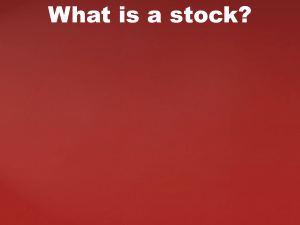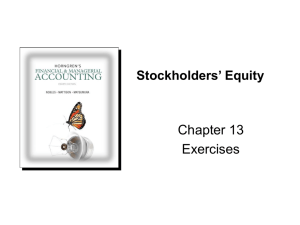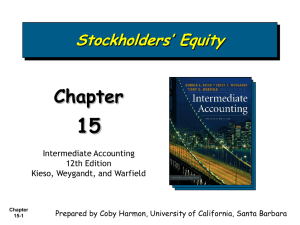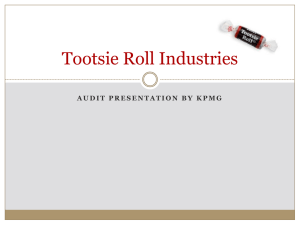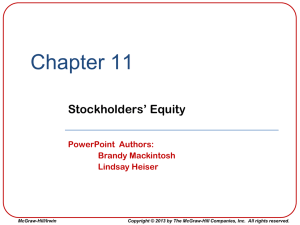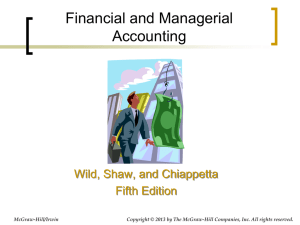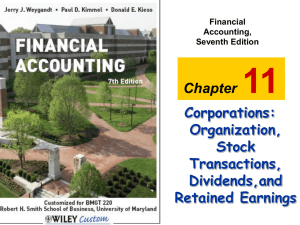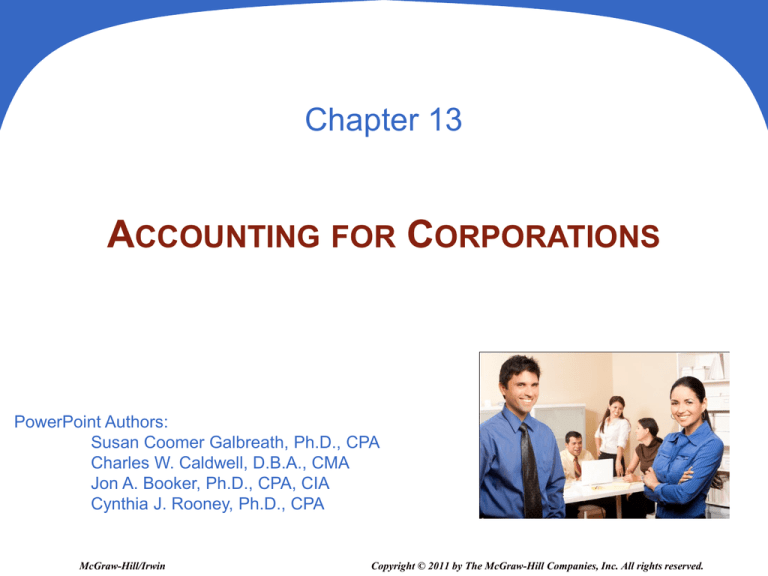
Chapter 13
ACCOUNTING FOR CORPORATIONS
PowerPoint Authors:
Susan Coomer Galbreath, Ph.D., CPA
Charles W. Caldwell, D.B.A., CMA
Jon A. Booker, Ph.D., CPA, CIA
Cynthia J. Rooney, Ph.D., CPA
McGraw-Hill/Irwin
Copyright © 2011 by The McGraw-Hill Companies, Inc. All rights reserved.
13 - 2
C1
CORPORATE FORM OF ORGANIZATION
An entity
created by law
Existence is
separate from
owners
Has rights and
privileges
Privately Held
Ownership
can be
Publicly Held
13 - 3
C1
CHARACTERISTICS OF CORPORATIONS
Advantages
Separate legal entity
Limited liability of stockholders
Transferable ownership rights
Continuous life
Lack of mutual agency for stockholders
Ease of capital accumulation
Disadvantages
Governmental regulation
Corporate taxation
13 - 4
C1
CORPORATE ORGANIZATION AND
MANAGEMENT
Stockholders
Board of Directors
President, Vice-President,
and Other Officers
Employees of the Corporation
13 - 5
C1
CORPORATE ORGANIZATION AND
MANAGEMENT
C orporate O rganiza tion C hart
Ultimate
control
Selected by a
vote of the
stockholders
S tockholders
B oard of D irectors
P resident
S ecretary
V ice P resident
F inance
V ice P resident
P roduction
Stockholders
usually meet
once a year
Overall
responsibility
for managing
the company
V ice P resident
M arketing
13 - 6
C1
RIGHTS OF STOCKHOLDERS
Vote at stockholders’ meetings
Sell stock
Purchase additional shares of stock
Receive dividends, if any
Share equally in any assets remaining
after creditors are paid in a liquidation
13 - 7
C1
STOCK CERTIFICATES AND TRANSFER
Each unit of
ownership is
called a share of
stock.
A stock certificate
serves as proof
that a stockholder
has purchased
shares.
When the stock is sold, the stockholder signs a transfer
endorsement on the back of the stock certificate.
13 - 8
C1
BASICS OF CAPITAL STOCK
Total amount of stock that a
corporation’s charter authorizes it to sell.
Stockholders' Equity
Common Stock, par value $.01;
authorized 250,000,000 shares; issued
and outstanding 92,556,295 shares
$925,563
Total amount of stock that has been
issued or sold to stockholders.
13 - 9
C1
BASICS OF CAPITAL STOCK
Par value is an
arbitrary amount
assigned to each
share of stock when
it is authorized.
Classes of Stock
Par Value
No-Par Value
Stated Value
Market price is the
amount that each
share of stock will
sell for in the market.
13 - 10
P1
ISSUING PAR VALUE STOCK
Par Value Stock
On September 1, Matrix, Inc. issued 100,000
shares of $2 par value stock for $25 per share.
Let’s record this transaction.
Dr
2,500,000
Sept. 1 Cash
Common Stock, $2 par value
Paid-in Capital in Excess
of Par Value, Common
Issued 100,000 shares of common stock.
Cr
200,000
2,300,000
13 - 11
P1
ISSUING PAR VALUE STOCK
Stockholders' Equity with Common Stock
Stockholders' Equity
Common Stock - $2 par value; 500,000 shares
authorized; 100,000 shares issued and
outstanding
$ 200,000
Paid-In Capital in Excess of Par
2,300,000
Retained earnings
650,000
Total stockholders' equity
$ 3,150,000
13 - 12
P1
ISSUING STOCK FOR NONCASH ASSETS
Par Value Stock
On September 1, Matrix, Inc. issued 100,000
shares of $2 par value stock for land valued at
$2,500,000. Let’s record this transaction.
Dr
2,500,000
Sept. 1 Land
Common Stock, $2 par value
Paid-in Capital in Excess
of Par Value, Common
Exchanged 100,000 common shares for land.
Cr
200,000
2,300,000
13 - 13
P2
CASH DIVIDENDS
Regular cash dividends provide a return to investors
and almost always affect the stock’s market value.
Corporation
Dividends
To pay a cash dividend, the
corporation must have:
1. A sufficient balance in
retained earnings; and
2. The cash necessary to
pay the dividend.
Stockholders
% of Corporations Paying Divends
100%
80%
75%
60%
40%
22%
20%
0%
Common
Preferred
13 - 14
P2
ACCOUNTING FOR CASH DIVIDENDS
Three important dates
Date of Declaration
Date of Record
Date of Payment
Record liability
for dividend.
No entry
required.
Record payment of
cash to stockholders.
13 - 15
P2
ACCOUNTING FOR CASH DIVIDENDS
On January 19, a $1 per share cash dividend is declared
on Dana, Inc.’s 10,000 common shares outstanding. The
dividend will be paid on March 19 to stockholders of
record on February 19.
Date of Declaration
Record liability
for dividend.
Jan. 19 Retained Earnings
Common Dividend Payable
Dr
10,000
Declared $1 per share cash dividend.
Cr
10,000
13 - 16
P2
ACCOUNTING FOR CASH DIVIDENDS
On January 19, a $1 per share cash dividend is declared
on Dana, Inc.’s 10,000 common shares outstanding. The
dividend will be paid on March 19 to stockholders of
record on February 19.
No entry required on February 19, the date of record.
Date of Payment
Record payment of
cash to stockholders.
Mar. 19 Common Dividends Payable
Cash
Dr
10,000
Paid $1 per share cash dividend.
Cr
10,000
13 - 17
P2
DEFICITS AND CASH DIVIDENDS
A deficit is created when a company incurs
cumulative losses or pays dividends greater
than total profits earned in other years.
Dana, Inc.
Balance Sheet (Stockholders' Equity Section)
December 31, 2011
Stockholders' Equity
Common stock $10 par value,
10,000 shares authorized and outstanding
$ 100,000
Retained earnings deficit
(8,500)
Total stockholders' equity
$
91,500
13 - 18
P2
STOCK DIVIDENDS
A distribution of a corporation’s own shares to its stockholders
without receiving any payment in return.
Why a stock dividend?
Can be used to keep the market price on the stock affordable.
Can provide evidence of management’s confidence that
the company is doing well.
Small Stock Dividend
Distribution is 25% of the previously outstanding shares.
Large Stock Dividend
Distribution is > 25% of the previously outstanding shares.
100 shares
HotAir, Inc.
Common Stock
$1 par
13 - 19
P2
RECORDING A SMALL STOCK DIVIDEND
Simmons has 100,000 shares of $1 par value stock outstanding. On
December 31, 2011, Simmons declared a 2% stock dividend, when the
stock was selling for $10 per share. The stock will be distributed to
stockholders on January 20, 2012. Let’s prepare the December 31 entry.
Capitalize retained earnings for the market
value of the shares to be distributed.
(100,000 × 2% = 2,000 × $10 = $20,000)
2,000 × $1 par
Dr
Dec. 31 Retained Earnings
20,000
Common Stock Dividend Distributable
Paid-In Capital in Excess
of Par Value
Declared a 2,000 share (2%) stock dividend.
Cr
2,000
18,000
13 - 20
Simmons, Inc.
Balance Sheet (Stockholders' Equity Section)
December 31, 2011
P2
Before the
stock
dividend.
Common stock - $1 par value,
250,000 shares authorized,
100,000 shares issued and outstanding
Paid-in capital in excess of par value
Total paid-in capital
Retained earnings
Total stockholders' equity
$
$
$
100,000
8,000
108,000
35,000
143,000
Simmons, Inc.
Balance Sheet (Stockholders' Equity Section)
December 31, 2011
Common stock - $1 par value,
250,000 shares authorized,
100,000 shares issued and outstanding
$
Common stock dividend distributable, 2,000 shares
Total common stock issued and to be issued
2,000
$
Paid-in capital in excess of par value
Total Paid-in capital
102,000
26,000
$
Retained earnings
Total stockholders' equity
100,000
128,000
15,000
$
143,000
After the
stock
dividend.
13 - 21
P2
RECORDING A LARGE STOCK DIVIDEND
Router, Inc. has 50,000 shares of $1 par value stock
outstanding. On December 31, 2009, Router declared a 40%
stock dividend, when the stock was selling for $8 per share.
The stock will be distributed to stockholders on January 20,
2010. Let’s prepare the December 31 entry.
Capitalize retained earnings for the minimum amount required
by state law, usually par or stated value of the shares.
(50,000 × 40% = 20,000 shares × $1 par value = $20,000)
Dr
Dec. 31 Retained Earnings
20,000
Common Stock Dividend Distributable
Declared a 20,000 share (40%) stock dividend.
Cr
20,000
13 - 22
P2
STOCK SPLITS
A distribution of additional shares of stock to
stockholders according to their percent ownership.
$10 par value
Common Stock
Old
Shares
100 shares
$5 par value
New
Shares
Common Stock
200 shares
13 - 23
C2
PREFERRED STOCK
A separate class of stock, typically having
priority over common shares in . . .
Dividend distributions
Distribution of assets in case of liquidation
Usually has a stated
dividend rate
Normally has no
voting rights
Corporations
with no
Preferred Stock
Corporations
with Preferred
Stock
73%
27%
13 - 24
C2
PREFERRED STOCK
Cumulative
Dividends in arrears must
be paid before dividends
may be paid on common
stock. (Normal case)
vs.
Noncumulative
Undeclared dividends from
current and prior years do
not have to be paid in
future years.
Consider the following Stockholders’ Equity section of
the Balance Sheet. The Board of Directors did not
declare or pay dividends in 2010. In 2011, the Board
declared and paid cash dividends of $42,000.
Common stock, $5 par value; 40,000 shares
authorized, issued and outstanding
Preferred stock, 9%, $100 par value; 1,000
shares authorized, issued and outstanding
Total Paid-In capital
$ 200,000
100,000
$ 300,000
13 - 25
C2
PREFERRED STOCK
If Preferred Stock is Noncumulative:
Year 2010: No dividends paid.
Year 2011:
1. Pay 2011 preferred dividend.
2. Remainder goes to common.
Preferred
$
-
If Preferred Stock is Cumulative:
Year 2010: No dividends paid.
Year 2011:
1. Pay 2010 preferred dividend in arrears.
2. Pay 2011 preferred dividend.
3. Remainder goes to common.
Totals
Preferred
$
-
$
Common
$
-
9,000
$
$
33,000
Common
$
-
9,000
9,000
$ 18,000
$
$
24,000
24,000
13 - 26
C2
PREFERRED STOCK
Participating
Dividends may exceed a
stated amount once
common stockholders
receive a dividend equal to
the preferred stated rate.
vs.
Nonparticipating
Dividends are limited to a
maximum amount each year.
The maximum is usually the
stated dividend rate.
(Normal case)
Reasons for Issuing Preferred Stock
To raise capital without sacrificing control
To boost the return earned by common stockholders
through financial leverage
To appeal to investors who may believe the common
stock is too risky or that the expected return on
common stock is too low
13 - 27
P3
TREASURY STOCK
Treasury stock represents shares of a company’s own
stock that has been acquired. Corporations might acquire
its own stock to:
1. Use their shares to buy other companies.
2. Avoid a hostile takeover.
3. Reissue to employees as compensation.
4. Support the market price.
Corporations and Treasury Stock
No Treasury Stock
38%
With Treasury
Stock
62%
13 - 28
P3
PURCHASING TREASURY STOCK
On May 8, Whitt, Inc. purchased 2,000 of its own
shares of stock in the open market for $4 per share.
May 8
Treasury stock, common
Cash
Dr
8,000
Cr
8,000
Purchase 2,000 treasury shares
at $4 per share.
Treasury stock is shown as a reduction in total
stockholders’ equity on the balance sheet.
13 - 29
P3
SELLING TREASURY STOCK AT COST
On June 30, Whitt sold 100 shares of
its treasury stock for $4 per share.
June 30
Dr
400
Cash
Treasury stock, common
Sold 100 shares of treasury
for $4 per share.
Cr
400
13 - 30
SELLING TREASURY STOCK
ABOVE COST
P3
On July 19, Whitt, Inc. sold an additional 500
shares of its treasury stock for $8 per share.
July 19
Cash
Treasury Stock, common
Paid-In Capital, Treasury Stock
Dr
4,000
Sold 500 treasury shares for $8 per share.
Shares Per Share Total
Sale
500 $
8.00 $ 4,000
Cost
500
4.00
2,000
Paid-In Capital
$ 2,000
Cr
2,000
2,000
13 - 31
SELLING TREASURY STOCK
BELOW COST
P3
On August 27, Whitt sold an additional 400
shares of its treasury stock for $1.50 per share.
Aug. 27
Dr
600
Cash
Paid-in Captial, Treasury Stock
Treasury Stock, Common
Cr
1,000
1,600
Sold 500 treasury shares for $1.50 per share.
Shares Per Share Total
Cost
400 $
4.00 $ 1,600
Sale
400
1.50
600
Difference
$ 1,000
13 - 32
C3
STATEMENT OF RETAINED EARNINGS
Retained earnings is the total cumulative amount of
reported net income less any net losses and dividends
declared since the company started operating.
Restricted Retained Earnings
Legal Restriction
Most states restrict
the amount of
treasury stock
purchases to the
amount of retained
earnings.
Contractual Restriction
Loan agreements
can include
restrictions on paying
dividends below a
certain amount of
retained earnings.
13 - 33
C3
APPROPRIATED RETAINED EARNINGS
A corporation’s directors can voluntarily limit
dividends because of a special need for cash
such as the purchase of new facilities.
Reed, Inc.
Statement of Retained Earnings
For Year Ended December 31, 2011
Retained earnings, 12/31/10
$
875,000
Plus: net income
155,600
Less: dividends declared
(80,000)
Retained earnings, 12/31/11
$
950,600
Appropriated retained earnings
Unappropriated retained earnings
(450,000)
$ 500,600
13 - 34
C3
PRIOR PERIOD ADJUSTMENTS
Prior period adjustments are corrections of material
errors in past years’ financial statements that result in a
change in the beginning balance of retained earnings.
Reed, Inc.
Statement of Retained Earnings
For Year Ended December 31, 2011
Retained earnings, 12/31/10, as previously reported
Prior period adjustment: Cost of equipment
incorrectly expensed (net of $28,000 income taxes)
Retained earnings, 12/31/10, as adjusted
Plus: net income
Less: dividends declared
Retained earnings, 12/31/11
$
875,000
72,000
947,000
155,600
(80,000)
$ 1,022,600
13 - 35
C3
STATEMENT OF
STOCKHOLDERS’ EQUITY
Matrix, Inc.
Statement of Stockholders' Equity
For the Year Ended December 31, 2011
Common stock and
(In millions)
capital in excess of par
Shares
Amount
Balance at December 31, 2010
821
$
2,500
Stock sales
17
500
Stock repurchases and retirement
(17)
(260)
Cash dividends declared
Other, net
Net income
Balance at December 31, 2011
821
$
2,740
Retained
Earnings
$ 9,500
(925)
(150)
70
5,100
$ 13,595
Total
$ 12,000
500
(1,185)
(150)
70
5,100
$ 16,335
This is a more inclusive statement than the statement of
retained earnings.
13 - 36
C3
STOCK OPTIONS
The right to purchase common stock at a fixed price over a
specified period of time. As the stock’s price rises above
the fixed option price, the value of the option increases.
Option
purchase
price $30
per share.
Market
price of
stock $75
per share.
Options are given to key employees to motivate them to:
focus on company performance,
take a long-run perspective, and
remain with the company.
13 - 37
A1
EARNINGS PER SHARE
Earnings per share is one of the most widely
cited accounting statistics.
Basic
earnings =
per share
Net income - Preferred dividends
Weighted-average common shares outstanding
13 - 38
A2
PRICE–EARNINGS RATIO
This ratio reveals information about the stock
market’s expectations for a company’s future growth
in earnings, dividends, and opportunities.
Price–
Earnings
Ratio
=
Market value per share
Earnings per share
If earnings go up,
will the market price
of my stock follow?
13 - 39
A3
DIVIDEND YIELD
Tells us the annual amount of cash dividends
distributed to common stockholders relative to
the stock’s market price.
Dividend
Yield
=
Annual cash dividends per share
Market value per share
13 - 40
A4
BOOK VALUE PER SHARE–COMMON
Reflects the amount of stockholders’ equity
applicable to common shares on a per share basis.
Stockholders’ equity applicable
Book value per
to common shares
=
common share
Number of common
shares outstanding
13 - 41
A4
BOOK VALUE PER SHARE–PREFERRED
Reflects the amount of stockholders’ equity
applicable to preferred shares on a per share basis.
Book value per
=
preferred share
Stockholders’ equity applicable
to preferred shares
Number of preferred shares
outstanding
13 - 42
GLOBAL VIEW
U.S. GAAP and IFRS have similar procedures for issuing common stock
at par, at a premium, at a discount, and for noncash assets.
Accounting for and reporting cash dividends, stock dividends, and
stock splits, are consistent under both U.S. GAAP and IFRS.
Accounting for treasury stock is consistent under both U.S. GAAP and
IFRS. Companies do not report gains or losses on transactions
involving their own stock.
Preferred stock that is redeemable at the option of the preferred
stockholder is reported between liabilities and equity under U.S. GAAP,
but it is reported as a liability under IFRS. Also, the issue price of
convertible preferred stock (and bonds) is recorded entirely under
preferred stock (or bonds), and none to the conversion feature under
U.S. GAAP. However, IFRS requires that a portion of the issue price be
allocated to the conversion feature.
13 - 43
END OF CHAPTER 13



